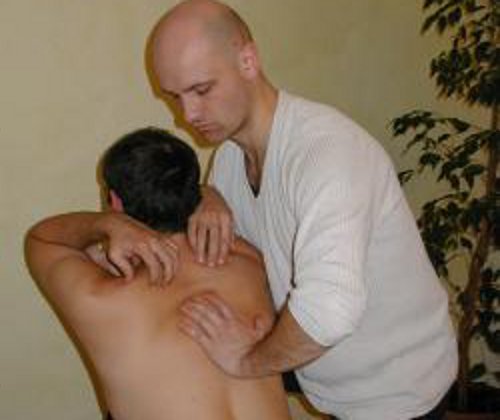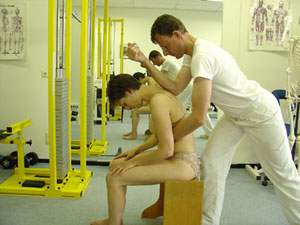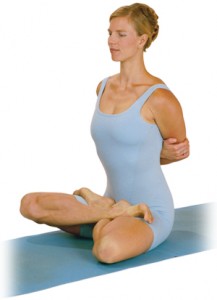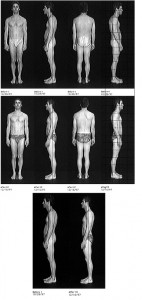 Do you suffer from chronic stress? Would you like to find a way to ease pain and improve performance in activities and performance? Then I might just have the answer for you. In just 10 sessions you could experience maximum well being of body and mind, Rolfing.
Do you suffer from chronic stress? Would you like to find a way to ease pain and improve performance in activities and performance? Then I might just have the answer for you. In just 10 sessions you could experience maximum well being of body and mind, Rolfing.
What is Rolfing?
 The name is strange, to be sure. While it may sound like what happened after a particularly rowdy frat party, it’s actually a method of assisted stretching named after Dr. Ida Rolf, pioneer of the technique.
The name is strange, to be sure. While it may sound like what happened after a particularly rowdy frat party, it’s actually a method of assisted stretching named after Dr. Ida Rolf, pioneer of the technique.
Dr. Rolf believed that there was more to health than the limitations of her time, and in the 1930s studied osteopathy, homeopathy, and chiropractic techniques. She developed a technique she called “Structural Integration,” meant to allow the body to work together as it was meant to originally.
Rolfing argues that each of our bodies has a natural alignment that is controlled by our movements and gravity. Our day to day activities, such as work, strength training, sports, and other movements can result in imbalances throughout the body, causing pain, discomfort, and weaknesses in our muscular gains.
This technique works with the body by addressing the connective tissues, or fascia. Fascia surrounds and supports all of the muscles, bones, organs, and even the nerves in our body. You can think of this web-like structure as the key to proper balance, function, and alignment throughout our bodies.
Generally people start with the Basic Ten, a group of ten to twelve sessions spaced from one week to one month apart each. The spacing allows the changes made in the previous session time to integrate. Session costs vary, but in my area they run about $120 for a 90 minute session, about the same as a massage.
How It Works
Rolfing is different than seeing a chiropractor or a massage therapist because it works at the connective tissue level. This technique uses intense pressure and stroking to stretch tight fascia back to proper length. Practitioners manipulate the fascia with pressure from their elbows, fingers, knees, and knuckles.
The goal is to make the fascia more flexible and relaxed, so that it naturally restores itself back into the proper form. The tension in your body from tightened fascia is deep, and that is why so much pressure needs to be applied. Generally it feels similar to a deep tissue massage.
Recently practitioners have been implementing gentler techniques. However it is worth all the intense pressure because results are long lasting. People will feel and look better for several months after their last session.
Remember that any practitioner should check in to gauge your comfort level, and don’t be afraid to speak up if you’re in significant pain. The body has a difficult time relaxing in the presence of too much discomfort, so it’s to your benefit to be as relaxed as possible during your session.
Are You A Candidate For Rolfing?
 People of all ages and shapes can benefit from Rolfing. If you are an athlete, fitness enthusiast, or someone that just likes to be active, Rolfing can help you achieve optimal performance. Also, people that experience high stress in the workplace are a good candidates for Rolfing.
People of all ages and shapes can benefit from Rolfing. If you are an athlete, fitness enthusiast, or someone that just likes to be active, Rolfing can help you achieve optimal performance. Also, people that experience high stress in the workplace are a good candidates for Rolfing.
Some things addressed through Rolfing are:
- Increasing performance with greater joint range of motion & overall flexibility
- Recovering from injuries and surgeries faster.
- Helping people feel younger and more energetic
- Treating chronic back pain.
- Recurring athletic injuries.
- Alleviating TMJ dysfunction.
- Addressing sciatica and other nerve related pain.
Athletes, fitness enthusiasts, and body builders tend to use the same muscles over and over again. This leads to tightness throughout the body that even stretching cannot address. Over time, flexibility decreases and the chance of injury increases.
With Rolfing, muscle fibers are manipulated to relax through deep pressure, allowing the muscle to gain maximum strength when training. This method is excellent for reaching areas that are hard to reach, and it can keep the body function more efficiently.
Research Findings
UCLA completed a study on Rolfing and found it “to create and maintain a more balanced energy system which conserves energy rather than expand it.” The results also found that the effectiveness of Rolfing showed body movements to be less constrained and smoother, as well as more balanced, after the sessions have been completed.
The University of Maryland found that Rolfing “significantly reduces chronic stress and changes body structure for the better.” This study examined the spinal curvature of subjects with intense lower back pain. The subjects not only experienced alleviation of pain, but the resulkts were long lasting and needed little to no maintenance after the sessions had been completed.
Rolfing allows people to live a pain-free and activity-filled life. Many athletes use it to return to sports after injury, while bodybuilders use it to keep their muscles moving efficiently so they get the most out of their workouts.
The “Ten Series”
 Now you are ready to sign up, but how do you start? The principle of Rolfing revolves around 10 sessions, hence why it is called “The Rolfing Ten Series.” These sessions progress so that you will optimize your shape and movement of the entire body.
Now you are ready to sign up, but how do you start? The principle of Rolfing revolves around 10 sessions, hence why it is called “The Rolfing Ten Series.” These sessions progress so that you will optimize your shape and movement of the entire body.
The first three sessions are called the “sleeve” sessions. This is because during these sessions the therapist focuses on loosening the surface layers of the connective tissues. During this time you will also work on breathing from the ribcage and diaphragm, as well as opening up the spine and learning how different parts of your body relate to the others.
Sessions 4 through 7 are known as the “core” sessions. Here you focus on the bottom of the pelvis and the top of your head. Also, throughout these sessions you will address the feet and how they connect to the deep abdominal muscles, while they work way up to your neck and head.
The last three sessions are called “integration”. Now you start to focus on smooth movements and coordination throughout your body. The practitioner addresses individual issues and these times are very unique to the person.
Putting It All Together
After completing all 10 sessions one can expect to feel better all over and have more freedom in of movement. Some say they feel taller because their backs are released of any previous tightness. You will be more aware of your body and how it all works together.
Other wonderful benefits are increase in energy, improved overall health, and increase in muscle strength and performance. Strength training is a constant shortening and bulking of the muscles. Rolfing will help the muscles become aligned so that they can lengthen out to its optimal state, which means more strength when lifting.
This form of alternative medicine is a more cost effective solution to surgery and drugs. All it takes is 10 sessions to allow your body to work at optimum efficiency!
